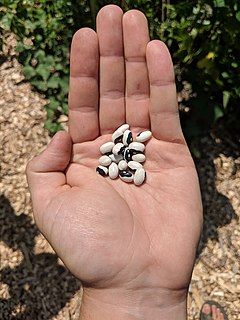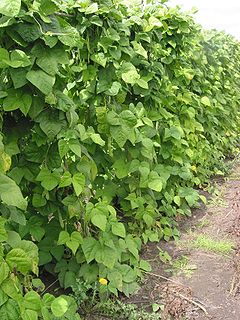Related Research Articles

A bean is the seed of one of several genera of the flowering plant family Fabaceae, which are used as vegetables for human or animal food. They can be cooked in many different ways, including boiling, frying, and baking, and are used in many traditional dishes throughout the world.

Phaseolus is a genus of herbaceous to woody annual and perennial vines in the family Fabaceae containing about 70 plant species, all native to the Americas, primarily Mesoamerica.

Rhizobium is a genus of Gram-negative soil bacteria that fix nitrogen. Rhizobium species form an endosymbiotic nitrogen-fixing association with roots of legumes and Parasponia.

Green beans are the unripe, young fruit of various cultivars of the common bean. Immature or young pods of the runner bean, yardlong bean, and hyacinth bean are used in a similar way. Green beans are known by many common names, including French beans, string beans, snap beans, snaps, and the French name haricot vert. They are also known as Baguio beans in Philippine English, to distinguish them from yardlong beans. Other locals in the vegetable farming regions of the Philippines refer these as "habitchuelas". It is commonly grown in the northern highlands of Benguet, Mountain Province and Nueva Vizcaya, and other mid-elevation areas in the country like Bukidnon, Quezon and Laguna.

Frijoles negros is a Latin American dish made with black beans, prepared in Guatemala, Cuba, Venezuela, Puerto Rico, Mexico, and other nations in Latin America. The black bean, a legume of the species Phaseolus vulgaris, is usually purchased in either canned or dried form. One cup of dried black beans yields approximately 2+1⁄2 cups of cooked beans. Black bean soup is another commonly prepared Cuban favorite.
Robert B. Mellor is a British scientist probably best known for his 1989 "unified vacuole theory".

Phaseolin is a prenylated pterocarpan found in French bean seeds and in the stems of Erythrina subumbrans.
Herbaspirillum lusitanum is a nitrogen-fixing bacterium found in root nodules of common beans. Phylogenetic analyses have shown this bacterium belongs to the genus Herbaspirillum. H. lusitanum lacks the nif gene. A nodD-like gene is present, but no other nod genes have been identified. The lack of nif and nod genes suggests H. lusitanum is an opportunistic bacterium capable of colonizing root nodules, but is unable to fix nitrogen.
Sinorhizobium fredii is a nitrogen fixing bacteria of the genus Sinorhizobium. It is a fast-growing root nodule bacteria. Sinorhizobium fredii exhibit a broad host-range and are able to nodulate both determinant hosts such as soy as well as indeterminate hosts including the pigeon pea. Because of their ease of host infection there is interest in their genetics and the symbiotic role in host infection and nodule formation.
Pararhizobium giardinii is a Gram negative root nodule bacteria. It forms nitrogen-fixing root nodules on legumes, being first isolated from those of Phaseolus vulgaris.
Rhizobium gallicum is a Gram-negative root-nodule bacterium. It forms nitrogen-fixing root nodules on legumes, being first isolated from those of Phaseolus vulgaris.
Phyllobacterium trifolii is a root-nodulating bacteria that was first isolated from nodules in Trifolium and Lupinus species. Its type strain is PETP02T.
Phyllobacterium ifriqiyense is a Gram-negative bacteria from the genus of Phyllobacterium which was isolated from root nodules from the plants Astragalus algerianus and Lathyrus numidicus.
Phyllobacterium leguminum is a Gram-negative bacteria from the genus of Phyllobacterium which was isolated from root nodules from the plants Argyrolobium uniflorum and Astragalus algerianus.
Phyllobacterium loti is a bacterium from the genus of Phyllobacterium which was isolated from nodules from the plants Lotus corniculatus in Uruguay.
Phyllobacterium myrsinacearum is a Gram-negative bacteria from the genus of Phyllobacterium which was isolated from sugar-beet roots. Phyllobacterium rubiacearum differs from Phyllobacterium myrsinacearum in only two nucleotides. Further analysis indicate that Phyllobacterium myrsinacearum and Phyllobacterium rubiacearum should be classified as only species.
Rhizobium lusitanum is a Gram negative root nodule bacteria, specifically nodulating Phaseolus vulgaris. Its type strain is P1-7T.
Sinorhizobium americanum is a bacterium first isolated from root nodules of Acacia species native of Mexico. Its type strain is CFNEI 156.
Pararhizobium is a genus of Gram-negative soil bacteria that fix nitrogen. It has been segregated from the genus Rhizobium. Pararhizobium forms an endosymbiotic nitrogen-fixing association with roots of legumes.
Phyllobacterium sophorae is a Gram-negative bacteria in the genus Phyllobacterium which has been isolated from the root nodules of the plant Sophora flavescens.
References
- ↑ LSPN lpsn.dsmz.de
- ↑ Straininfo of Phyllobacterium endophyticum
- ↑ Flores-Felix, J. -D.; Carro, L.; Velazquez, E.; Valverde, A.; Cerda-Castillo, E.; Garcia-Fraile, P.; Rivas, R. (2012). "Phyllobacterium endophyticum sp. nov., isolated from nodules of Phaseolus vulgaris". International Journal of Systematic and Evolutionary Microbiology. 63 (Pt 3): 821–6. doi:10.1099/ijs.0.038497-0. PMID 22611197.
- ↑ UniProt